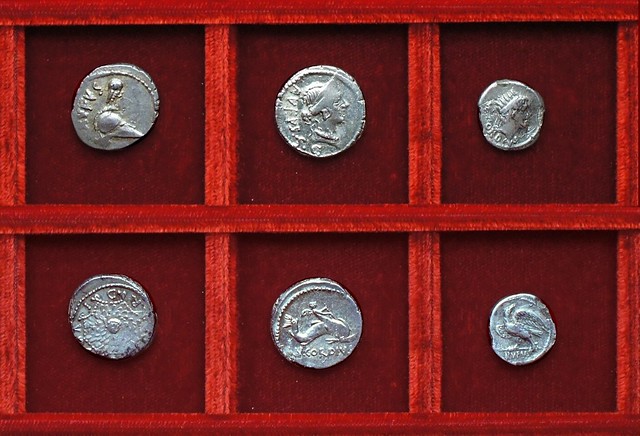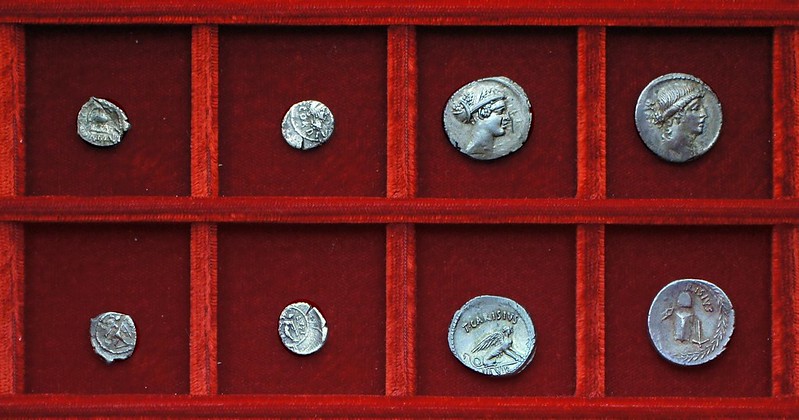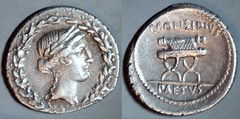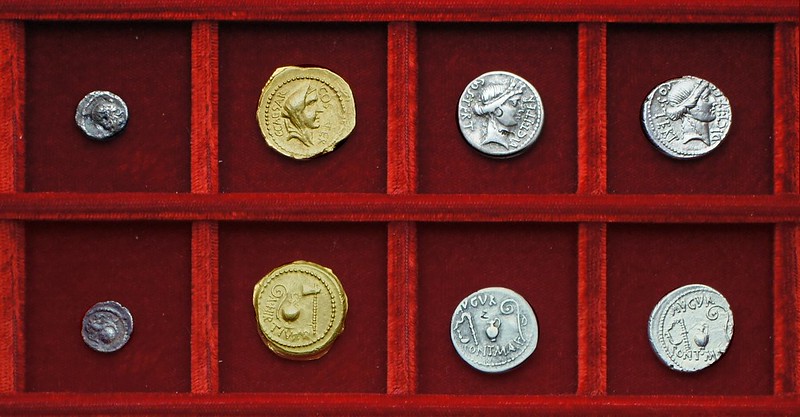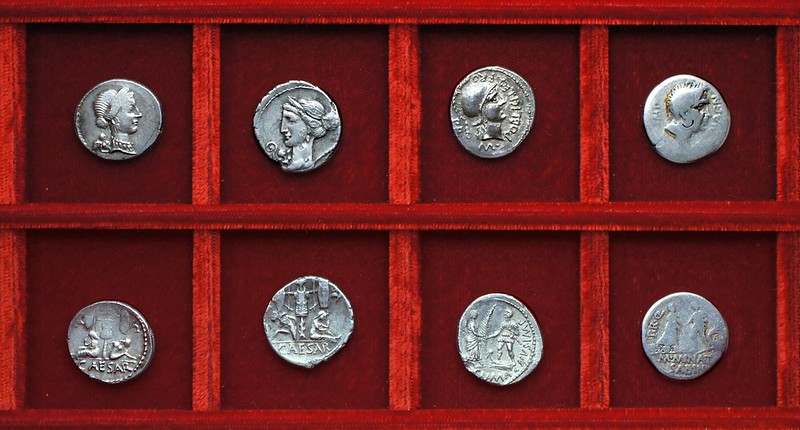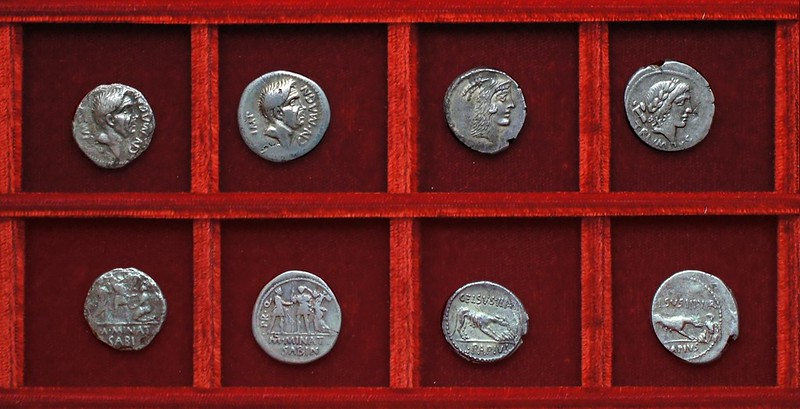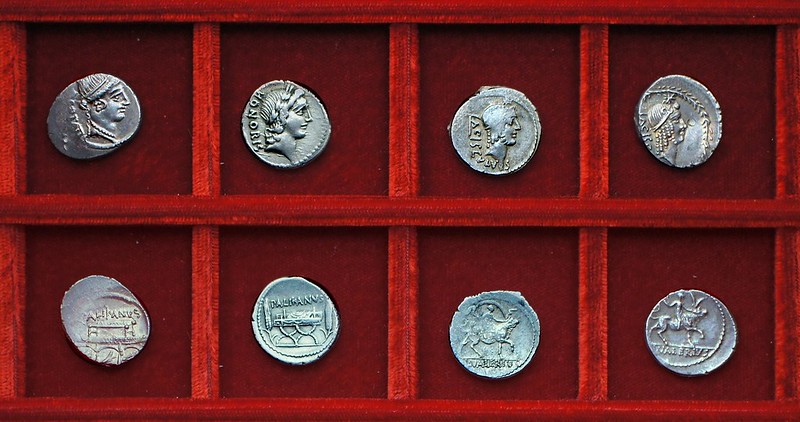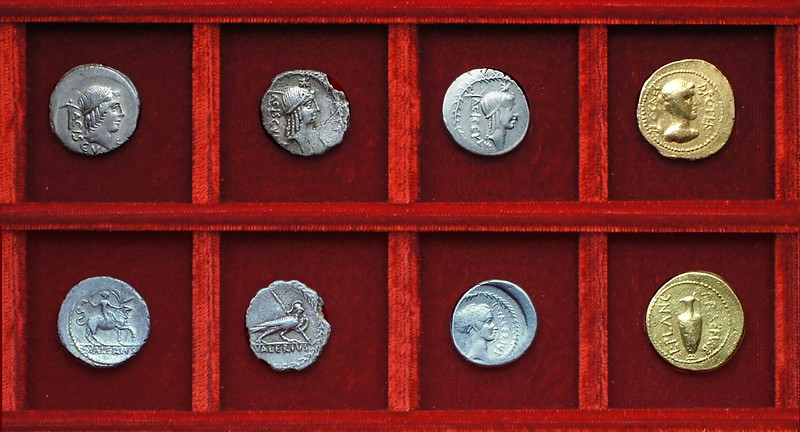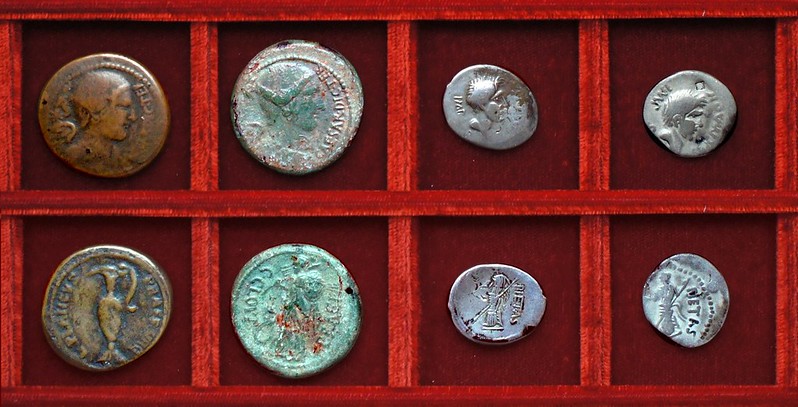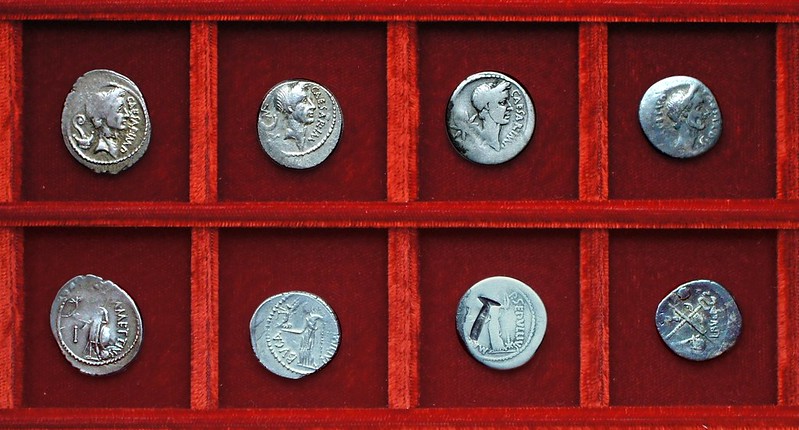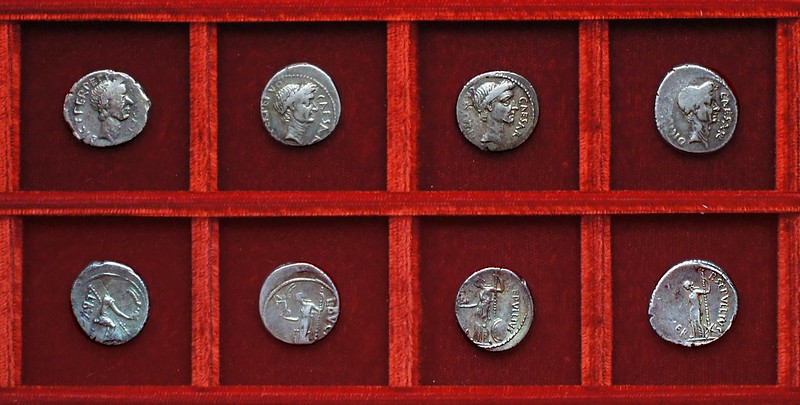Part 16 RRC 463 to RRC 482, 46BC to 44BC, Julius Caesar dictatorship to the Ides of March, Cnaeus Pompey, Munda

|
Specialist Supplements:
1. Roman Coins of Luceria and Canusium
2. Anonymous Struck Bronze Coins of the Roman Republic
3. Anonymous Roman Republican Denarii and Victoriati (Steve Brinkman's site)
Principal Coins of the Roman Republic
Part 16 RRC 463 to RRC 482, 46BC to 44BC, Julius Caesar dictatorship to the Ides of March, Cnaeus Pompey, Munda
RRC 463 MN.CORDIVS RVFVS Cordia 46BC Rome denarii.
RRC 463 MN.CORDIVS RVFVS Cordia 46BC Rome denarii, quinarius. The quinarius variant RRC 463/4c with short parallel rays is very much rarer than the types with longer splayed rays.
RRC 463 MN.CORDIVS RVFVS Cordia 46BC Rome sestertii.
We now see large scale resumption of the sestertius fraction, for the first time since the second Punic war, aside
from a single rare Social War issue of Lucius Piso Frugi. Whilst many civil-war era sestertii are very rare,
others are relatively plentiful including at right the Venus with Cupid walking type RRC 463/6. These small
coins are difficult to see - if you click on the photo it enlarges to double size in a separate tab.
RRC 464 T.CARISIVS IIIVIR Carisia 46BC Rome denarii.
The Carisia denarius showing a minting scene is a famously self-referential type: a coin referring to coining.
RRC 464 T.CARISIVS IIIVIR Carisia 46BC Rome denarii, sestertius. The middle two Carisia denarii show weak strikes typical of the Rome mint in this period, including with the portrait coinage of Julius Caesar. The mottled surface in left field of the biga type is also typical of surface effects that appear in weakly struck areas, sometimes with raised dots. Thus the flans had mottled or dotted surfaces prior to being struck, perhaps from being beaten with the equivalent of a meat tenderiser! The sestertii types are often surprisingly detailed and include interesting imagery, with a female panther holding a standard on Pan's reverse. Unfortunately Cathy King's error-filled book on Roman Quinarii failed to take as its obvious scope all the gold and silver fractions. Few collections have a representative sample of these small coins, so their types are not well known. Click photo to enlarge.
RRC 464 T.CARISIVS IIIVIR Carisia 46BC Rome sestertius.
Click photo to enlarge.
RRC 465 C.CONSIDIVS PAETVS Considia 46BC Rome denarii, quinarius.
The Quinarii of the period were probably struck in much smaller quantities than the sestertii - they appear
perhaps less frequently and the sestertii must have suffered much greater attrition due to their tiny sizes.
RRC 465 C.CONSIDIVS PAETVS Considia 46BC Rome denarius. Davis coll. An unusually well made example of this normally shoddy coinage. What is on the curule chair? RRC mentions a wreath but it looks more like a tablet. The chair's surface is nicely done, perhaps a mesh of leather straps? I suspect all the denarius variants of this issue have yet to be published.
RRC 465 C.CONSIDIVS PAETVS Considia 46BC Rome sestertius.
Click photo to enlarge.
RRC 466 C.CAESAR A.HIRTIVS Julius Caesar Hirtius 46BC Rome aureus.
This massive issue of gold aureii was undoubtedly struck for Caesar's quadruple triumph in April 46BC.
The triumph celebrated victories in four wars:
His Gallic wars that ended in 50BC, his naval battle on the Nile 47BC, where together with Cleopatra VII he
defeated Queen Arsinoe IV and King Ptolemy XIII, and secured the throne for Cleopatra, his victory over Pharnaces
of Pontus at Zela in 47BC and his war against Juba of Numidia that culminated at Thapsus in April 46BC. Of
course the latter was really a conflict with the last of the Pompeians, Scipio and Cato. Caesar held his triumph
in November 46BC which was a very long and confusing month as he also reformed the calendar that month, adding
80 days to restore the seasons to their natural order, and setting a year of 365 days with a leap year every
fourth year. 46BC was known as annus confusionis ("year of confusion"), no doubt with good reason.
RRC 467 DICT ITER Julius Caesar 46BC W:Sicily denarii.
RRC noted the mint for RRC 467 as "uncertain", but as Woytek moved the RRC 458 Aeneas type to Asia to finance the
war against Pompey in 48BC to 47BC, RRC 467 now fills the necessary role of campaign finance for the Africa war
in 46BC, which Crawford's review of Arma et Nummi supports. The letters D and M are usually take to
stand for Donativum and Munus though it is a mystery why the pay for Caesar's army fighting
Juba, Scipio and Cato should be marked with words meaning gift or donation.
RRC 468 CAESAR Julius Caesar 46BC to 45BC Spain denarii
RRC 469 CN.MAGNVS M.POBILICI Cnaeus Pompey 46BC to 45BC Spain denarius
RRC 470 CN.MAGN M.MINAT SABIN Cnaeus Pompey 46BC to 45BC Spain denarius.
The coins on this tray were struck for the opposite sides in Spain before the battle of Munda March 45BC.
RRC 470 CN.MAGN M.MINAT SABIN Cnaeus Pompey, Minatia 46BC to 45BC Spain denarii
The coins of Marcus Minatius Sabinus for Cnaeus Pompey and showing the head of Pompey the Great are of
very high artistic quality and production standards. It is a complex issue with one die being later
recut for use by Sextus Pompey after Munda in RRC 477. I do not show on this tray RRC 471, the janus Prow bronze
As struck by Cnaeus Pompey, of rather poor production standards, and a precursor to the massive and
probably long lasting bronze currency issued by his brother Sextus, RRC 479.
RRC 472 L.PAPIVS CELSVS Papia 45BC Rome denarii.
Admiral Smyth, in cataloguing the Duke of Northumberland's collection, writes a nice explanation of this type.
"A she-wolf, holding a burning brand in her mouth, kindles a heap of combustibles, on the other side of which an
eagle fans and animates the sparks with its wings. This at once shows the Samnite origin of the Papii,
and illustrates the well-known legend related by Dionysius of Halicarnassus, respecting the fire so conveniently
made for Aeneas, while founding Lavinium. This was the city which they say he built subsequent to the defeat of
Turnus, on the banks of the Numicus, due south of Rome, and named after the King of Latium's daughter.
Being on a dead plain, it was soon found that Lavinium was altogether indefensible against a vigorous enemy.
Recourse was therefore had to the neighbouring heights, where they founded a second city, Lanuvium,
in a pleasing and commanding situation. This seems to be the fact which connects this obverse showing Juno Sospita,
with the reverse before us; for there was in Lanuvium a grand Temple of Juno, who was worshipped there,
with special pomp and ardour, under the three names Moneta, Regina, and Sospita,
the last being the most appropriate and tutelar. Herein we are reminded of the modem infinity of madonnas".
The alternate reverse evidently shows a personification of the Roman triumph with spoils over his
shoulder and, in case of doubt, TRIVMPVS is written below.
RRC 473 PALIKANVS Lollia Rome 45BC denarii.
The first coin illustrates the Rostrum in the Roman Forum with the captured prows of enemy ships in the
arches and a curule chair above. The Rostrum was a platform for speakers that faced the Comitia and
the Senate House. In the arches below there were six rostra captured at the battle of Antium at the mouth of the
river Astura in 338BC. Roman naval forces commanded by Gaius Maenius defeated the Latin
armies of Antium, Lanuvium, Aricia and Velitrae.
RRC 474 L.VALERIVS ACISCVLVS Valeria Rome 45BC denarii.
RRC 474 L.VALERIVS ACISCVLVS Valeria Rome 45BC denarii. RRC 475 L.PLANC C.CAES Julius Caesar Plautia Plancus C:45BC W:late 46BC to early 45BC, Rome aureus. The denarius at left is not listed in RRC. It is a variant of RRC 474/1 with a large jewel on Apollo's forehead rather than a star. The right-hand denarius shows the Sybil or Cumae on its reverse. The ruins at Cumae are very evocative and I have separately written about Cumae and the Sybil in a web-essay about ancient Campania.
RRC 474 L.VALERIVS ACISCVLVS Valeria Rome 45BC denarius. Davis coll. A rare type with Anguipedic giant.
RRC 475 L.PLANC C.CAES Julius Caesar Plautia Plancus forgery dupondius.
This is an evident forgery, tooled from an RRC 476 dupondius, but it fooled enough experts to be donated to the
British Museum and illustrated in Grueber's British Museum catalogue plate LIII (this coin). This an electrotype
which was given by the BM to William Boyd when he donated the coin.
RRC 476 CAESAR C.CLOVI Julius Caesar Clovia C:45BC, W:late 46BC to early 45BC, C:uncertain mint, W: Rome dupondius.
RRC 477 SEX MAGNVS IMP PIETAS Sextus Pompey C:45BC to 44BC, W:44BC, C:Spain Salpensa, W:South Spain camp mint denarii.
T.V. Buttrey's article on the
Pietas Denarius of Sextus Pompey
is available in condensed form on my website. This series had poor production standards; the two examples
above are relatively clear.
RRC 479 MAGNVS EPPIVS LEG Sextus Pompey, Eppius as Legate C:45BC to 44BC, W:from end 43BC, C: Spain, W:Sicily As.
RRC 479 MAGN IMP Sextus Pompey C:from 45BC, W:42BC to 38BC, C:Spain,Sicily, W:Sicily As.
I noted in the introduction to
Part 14, RRC 440 to RRC 462 that this massive coinage of bronze may have been minted until
the end of Sextus Pompey's supremacy in 36BC. A die study has been carried out by Rodolfo Martini.
RRC 480/1 L.BVCA, Julius Caesar, Aemilia January 44BC Rome denarii.
For the RRC 480 types I list each type separately. Most modern scholars consider that RRC 480/1
type shows Selene and Endymion and NOT the dream of Sulla (Crawford in his 1978 Edinburgh catalogue,
Woytek in Arma et Nummi, J.Rufus Fears in ANS Museum Notes 1975, C.Congrossi in Storia Antica 1976).
Crawford, in supporting Fears' Selene and Endymion attribution but still placing the coin at the beginning
of the year, comments: "I still regard the absence of any circumreference to Caesar on
what is a small and isolated issue of the coinage of 44BC as suggesting a date at the beginning of the year
rather than after the death of Caesar. I am quite sure that the significance of Selene and Endymion on late
sarcophagi is unlikely to be relevant to a type of a denarius of 44BC, that the type is not a funeral tribute
to a dead Dictator and that the peaceful passing of Endymion is wildly inappropriate to exemplify the
eternal felicity of the murdered Caesar."
RRC 480/2 DICT QVART, METTIVS, Julius Caesar, Mettia early February 44BC Rome denarii.
The RRC 480/2 type with CAESAR DICT QVART legend is the only
coin proving the existence of a Julius Caesar lifetime portrait; all other portrait types have DICT IN PERPETVO or other
titles, and an uncertain proportion may have been struck after his death. Caesar ceased being DICT QVART on
15th February 44BC which provides a certain terminus anti-quem for RRC 480/2 that is shared by no other
Roman portrait type. This is for certain the first living portrait of a Roman on a Roman coin.
I need to tackle the contentious subject of the arrangement of RRC 480 within 44BC. Michael Crawford briefly explains his arrangement on the basis of titles and style. Clearly, after RRC 480/1, RRC 480/2 DICT QVART comes first, and DICT IN PERPETVO, RRC 480/6 to 480/16, must post date 15th February. Crawford places CAESAR IMP, RRC 480/3 to 480/5, as preceding DICT IN PERPETVO, and by implication no later than February, on the basis of the fine style of the CAESAR IMP coins which he compares with RRC 480/2 DICT QVART. So all the coins up until RRC 480/16 might be lifetime issues. After these he places CAESAR IMPER RRC 480/17 and 480/18, citing their "newly designed, hastily executed reverses", from which one may read that he believe them to post-date the assasination - otherwise why the rush? Once we reach PARENS PATRIAE and CLEMENTIAE CAESARIS, RRC 480/19 to RRC 480/22, the coins were certainly issued after Caesar's death, since RRC 480/22 shows Mark Antony's portrait, and reverse or obverse types are shared among the four issues. These issues were unlikely to have continued as far as September, by when Cicero had launched into his Philippics against Mark Antony, hardly a comfortable time to be issuing portrait coins of oneself. So Crawford's overall schedule is front-loaded, with RRC 480/1 through RRC 480/5 until February, RRC 480/6 through RRC 480/18 extending through and after the Ides of March, and RRC 480/19 through RRC 480/22 in perhaps early summer. However we do have to impute the arrangement from Crawford's comments - he does not directly propose any dates.
Andrea Alföldi in his comprehensive die study, "CAESAR in 44 v.Chr", Vol.2, 1974, arranges the coins in month order. Alföldi's arrangement is very similar to that of Crawford, who worked in parallel (both published in 1974). It only differs in placing the issue of MARIDIANVS as a posthumous issue with PARENS PATRIAE, CLEMENTIAE CAESARIS and Mark Antony's portrait coin. The minimal differences between these two great scholars should give comfort as to the logic of their arrangements. Here are Alföldi's dates: RRC 480/1 Buca: January; RRC 480/2 DICT QVART: early February; RRC 480/3/4/5 CAESAR IMP: late February; RRC 480/6/7/8/9/10/11/12/13/14/ DICT IN PERPETVO: early March; RRC 480/17/18 CAESAR IMPER: late March; RRC 480/19/20 PARENS PATRIAE: April; RRC 480/15/16 MARIDIANVS: April; RRC 480/21/22 CLEMENTIAE CAESARIS and Mark Antony: April. Given Alföldi's specialist focus on the issue and the minial differences between Alföldi and Crawford, I have cited Alföldi's date against each issue.
RRC 480/3 IMP, METTIVS, Julius Caesar, Mettia late February 44BC Rome denarius.
RRC 480/4 IM.P.M., BVCA, Julius Caesar, Aemilia late February 44BC Rome denarius.
RRC 480/5 IMP, MACER, Julius Caesar, Sepullia late February 44BC Rome denarius.
RRC 480/6 DICT PERPETVO, BVCA, Julius Caesar, Aemilia early March 44BC Rome denarius.
RRC 480/7 DICT PERPETVO, BVCA, Julius Caesar, Aemilia early March 44BC Rome denarius.
RRC 480/8 DICT PERPETVO, BVCA, Julius Caesar, Aemilia early March 44BC Rome denarius.
RRC 480/9 DICT PERPETVO, MACER, Julius Caesar, Sepullia early March 44BC Rome denarius.
RRC 480/10 DICT PERPETVO, MACER, Julius Caesar, Sepullia early March 44BC Rome denarius.
RRC 480/13 DICT PERPETVO, MACER, Julius Caesar, Sepullia early March 44BC Rome denarius.
RRC 480/14 DICT PERPETVO, MACER, Julius Caesar, Sepullia early March 44BC Rome denarius.
RRC 480/15 DICT IN PERPETVO, MARIDIANVS, Julius Caesar, Cossutia April 44BC Rome denarius.
RRC 480/16 DICT PERPETVO, MARIDIANVS, Julius Caesar, Cossutia April 44BC Rome denarius.
RRC 480/17 IMPER, METTIVS, Julius Caesar, Mettia late March 44BC Rome denarius.
RRC 480/19 PARENS PATRIAE, MARIDIANVS, Julius Caesar, Cossutia April 44BC Rome denarius.
RRC 480/21 CLEMENTIAE CAESARIS, MACER, Julius Caesar, Sepullia April 44BC Rome denarius.
RRC 480/22 MACER, Mark Antony, Sepullia April 44BC Rome denarius.
RRC 481 CAES DIC QVAR COS QVINC Julius Caesar early February 44BC Rome aureus.
Based on the DIC QVAR title I place this aureus coincident with RRC 480/2.
RRC 482 CAESAR IMP Octavian late February 44BC uncertain mint denarius.
This extremely rare type with a chariot at the base of a trophy has traditionally been assigned to Julius
Caesar, with which Crawford concurs, noting that the titles are the same as RRC 480/3 to 480/5.
So, I give it the same date.
Nothing is known for certain about this rare coin; it might equally well be a later issue of Octavian.
Specialist Supplements:
1. Roman Coins of Luceria and Canusium
2. Anonymous Struck Bronze Coins of the Roman Republic
3. Anonymous Roman Republican Denarii and Victoriati (Steve Brinkman's site)
All content copyright © 2004-2013 Andrew McCabe unless otherwise noted. If you've any questions or comments please contact me on the Yahoo Group RROME: http://groups.yahoo.com/group/RROME.
Alternately you can leave comments against any coin picture, just click on the picture and write in the comment box.
Site hosted free courtesy of VCoins.com
Ancient Coins on Vcoins
comment: this page is RRC463.html







